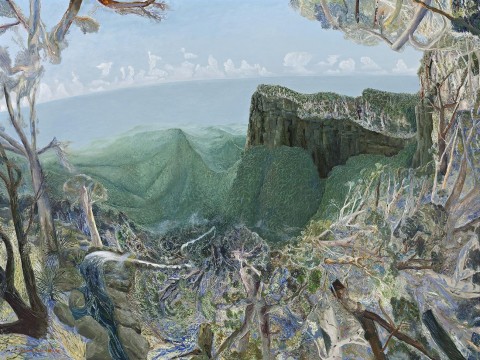TOWARDS THE SEA, FROM SPRINGBROOK, 1995
WILLIAM ROBINSON
oil on linen
137.5 x 183.0 cm
signed and dated lower left: William Robinson 95
inscribed with title verso: TOWARDS THE SEA FROM SPRINGBROOK
Ray Hughes Gallery, Sydney
Private collection, Melbourne, acquired from the above in 1996
William Robinson, Ray Hughes Gallery, Sydney, 28 June – 24 July 1996, cat. 2 (illus. in exhibition catalogue, p. 2)
William Robinson – A Retrospective, Queensland Art Gallery, Brisbane, 31 August – 11 November 2001; National Gallery of Australia, Canberra, 14 December 2001 – 10 March 2002 (label attached verso)
Seear, L. (ed.), Darkness and Light, The Art of William Robinson, Queensland Art Gallery, Brisbane, 2001, pl. 69, p. 126 (illus.)
Hart, D. (et. al), William Robinson. The Transfigured Landscape, Queensland University of Technology and Piper Press, Brisbane, 2011, p. 98 (illus.)
‘... To see one of Robinson’s landscapes is to be in it as well, to walk, and maybe to forage, with the painter through gum-thicketed gullies where any difference between the sky and its reflection is hard to tell – and probably unnecessary to know. The viewer is required to take a leap of faith, and execute something akin to a cartwheel, before penetrating Robinson’s dizzy realms. The resulting experience is partly aesthetic, partly athletic ...’1
With its multiple viewpoints and sweeping panorama of earth, sea and sky, of darkness and light, Towards the Sea, from Springbrook, 1995 encapsulates brilliantly the highly original landscapes for which William Robinson has become so widely acclaimed and admired. Robinson is unique in his devotion to an environment hitherto neglected by most artists – the ancient, labyrinthine rainforests of his immediate surroundings in the coastal hinterland of Southern Queensland and Northern New South Wales. Similarly, where the Australian landscape tradition has been characterised by a strong horizontality, Robinson here deliberately eschews established figure-ground relationships and conventional one-point perspective to transform landscape into a multidimensional experience – allowing every fold and fissure to be explored, yet still preserving a sense of panoramic continuity.
Immortalising those elements of nature which seem eternal – endless forest teeming with life; infinite untraversed oceans; majestic rifts of sky – Towards the Sea, from Springbrook is a powerful manifestation of the artist’s enduring interest in the relationship between man and the cosmos. By contrast however, to his earlier farmyard scenes and bucolic landscapes which feature the genial folk figures of Bill and his wife, Shirley, now the viewer is confronted with vast primordial wilderness which, upon first glance, may well be construed metaphorically as a sign of mankind’s loneliness or spiritual abandonment. Yet, as author Hannah Fink vehemently asserts, in fact the contrary holds true – the artist here reveals himself through his pictorial absence, and God is closest to his subject in desolation. Thus for Robinson, ‘finding himself’ as a painter, appreciating the landscape and becoming closer to God are all inextricably linked.2 Indeed, describing the experience of walking through the forest of 2000 year-old beech trees near his property at Springbrook, the artist poignantly recalls his visit to one of the world’s greatest pilgrimage destinations: ‘I want to show the presence of God somehow, not only through the mystery of walking through Chartres Cathedral and walking through this forest, but also something about the nature of providence’.3
Abandoning narrative for more universal and metaphysical concerns, thus in Towards the Sea, From Springbrook Robinson celebrates the sheer genius of creation itself – capturing the power of this silent, eternal landscape by conveying not simply that which he observes but importantly, that which he perceives within himself in his quest for meaning and a spiritual connectedness with the land. Like Wordsworth's ‘emotion recollected in tranquility’, for Robinson the process of painting is about 'contemplating things felt or remembered'. As Hannah Fink illuminates, '… wholeness resides in the experience of the landscape itself – as such, his paintings may be considered both compelling approximations of, and poetic tributes to, that sacred moment in which the physical and spiritual become synonymous’.4
1. James, B., ‘A Landscape We Thought We Knew’, Sydney Morning Herald, Sydney, 29 January 2003, p. 15
2. Fink, H, ‘Light Years: William Robinson and the Creation Story’, in Seear, L., (ed.) Darkness and Light: The Art of William Robinson, exhibition catalogue, Queensland Art Gallery, Brisbane, 2001, p. 27
3. Robinson quoted ibid.
4. Fink, op. cit.
VERONICA ANGELATOS
